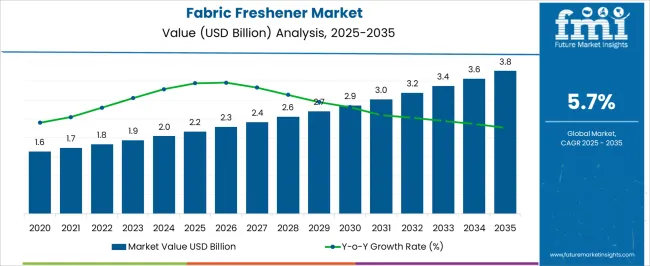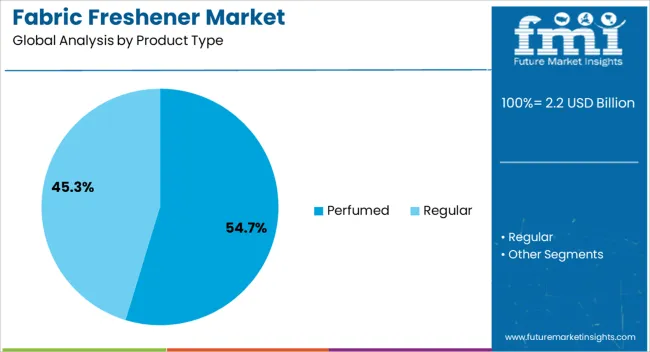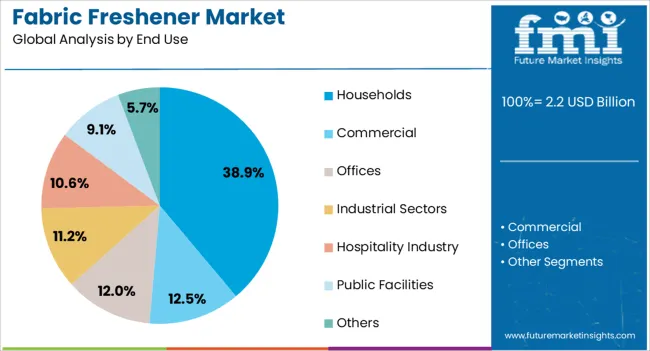The Fabric Freshener Market is estimated to be valued at USD 2.2 billion in 2025 and is projected to reach USD 3.8 billion by 2035, registering a compound annual growth rate (CAGR) of 5.7% over the forecast period.
The fabric freshener market is witnessing steady growth, supported by increasing consumer focus on hygiene, lifestyle enhancement, and indoor air quality. Industry announcements and product innovation briefings have emphasized a rising demand for convenient odor control solutions that go beyond traditional cleaning practices.
This demand has been amplified by urban living environments, where space constraints and limited access to frequent laundering have driven the adoption of fabric fresheners. Leading manufacturers have diversified their portfolios with fragrances tailored to regional scent preferences and functional claims such as allergen removal, pet odor neutralization, and fabric care.
The market has also benefited from the surge in homecare spending, with consumers seeking products that offer freshness and personalization. Product packaging innovations, eco-conscious ingredients, and allergen-free formulations are further elevating brand differentiation. Future growth is expected to be shaped by demand from households, increasing availability in mass retail formats, and the popularity of perfumed variants. The market is anticipated to expand through targeted marketing, premium scent offerings, and a growing affinity for on-the-go fabric care products.

| Metric | Value |
|---|---|
| Fabric Freshener Market Estimated Value in (2025 E) | USD 2.2 billion |
| Fabric Freshener Market Forecast Value in (2035 F) | USD 3.8 billion |
| Forecast CAGR (2025 to 2035) | 5.7% |
The market is segmented by Product Type, End Use, and Distribution Channel and region. By Product Type, the market is divided into Perfumed and Regular. In terms of End Use, the market is classified into Households, Commercial, Offices, Industrial Sectors, Hospitality Industry, Public Facilities, and Others. Based on Distribution Channel, the market is segmented into Supermarkets/Hypermarkets, Direct, Indirect, Specialty Stores, Independent Stores, Online Stores, and Others. Regionally, the market is classified into North America, Latin America, Western Europe, Eastern Europe, Balkan & Baltic Countries, Russia & Belarus, Central Asia, East Asia, South Asia & Pacific, and the Middle East & Africa.

The Perfumed segment is projected to account for 54.7% of the fabric freshener market revenue in 2025, emerging as the most preferred product category. Growth in this segment has been driven by consumer desire for lasting freshness and personalized scent experiences across various fabric types.
Manufacturers have responded with diverse fragrance options inspired by florals, citrus, aromatherapy, and nature-based themes, appealing to a broad range of consumer sensibilities. Fragrance innovation has played a central role in product positioning, with marketing efforts highlighting mood enhancement and home ambiance benefits.
Retail data has shown a stronger sales performance for perfumed variants due to their dual function as both odor neutralizers and scent enhancers. Additionally, the segment has gained popularity in emerging markets where consumers associate perfumed products with hygiene and luxury. As brands continue to expand seasonal and premium fragrance lines, the Perfumed segment is expected to maintain its dominance in both daily use and special-purpose fabric freshening applications.

The Households segment is projected to contribute 38.9% of the fabric freshener market revenue in 2025, sustaining its lead as the primary end-use category. This segment’s growth has been influenced by changing homecare routines, where consumers prioritize convenience, cleanliness, and air quality.
Increased usage of upholstered furniture, drapes, and reusable home textiles has created recurring demand for fabric freshening solutions that are quick and effective. Households have integrated fabric fresheners into daily routines, particularly in densely populated urban centers where ventilation is limited and odor build-up occurs more frequently.
Lifestyle publications and brand reports have noted increased consumer interest in dual-purpose fresheners that also condition fabrics or claim to remove allergens. Additionally, heightened awareness of home aesthetics and wellness trends has driven product trials, especially among younger households and pet owners. With fabric fresheners positioned as affordable indulgences that deliver instant results, the Households segment is expected to remain a strong driver of market consumption.

The Supermarkets/Hypermarkets segment is projected to capture 32.6% of the fabric freshener market revenue in 2025, maintaining its lead among distribution channels. Growth in this segment has been supported by the format’s ability to offer variety, convenience, and immediate product availability to a broad consumer base.
Supermarkets have become key platforms for consumer discovery of homecare products, with in-store displays and scent testers enhancing engagement. Personal care and home cleaning aisles in hypermarkets have expanded shelf space for fabric fresheners, often featuring promotional bundles and introductory offers that boost purchase volumes.
Strategic partnerships between manufacturers and retail chains have also ensured consistent stock availability and brand visibility. Furthermore, supermarkets have served as important access points in both urban and semi-urban markets, appealing to consumers who prefer physical inspection before purchasing scented products. As consumers continue to shop for fabric care solutions alongside groceries and other essentials, the Supermarkets/Hypermarkets segment is expected to retain its stronghold in the distribution landscape.
Consumer Awareness of Hygiene Shows Bode in the Fabric Freshener Industry
With changing lifestyles and rising social life, consumers are now more conscious about hygiene and cleanliness. Consumers have shifted to standardization of home décor to keep their homes visually appealing and smell fresh. Especially the wake of the COVID-19 pandemic has generated more concerns about health and hygiene.
Busy lives of individuals from the cooperate world have also impacted the uptrend of textile fresheners. Need for quick and efficient solutions for fabrics and household rugs, sheets, and blankets has boosted the growth opportunities in the textile freshener sector.
Shift toward Environment-friendly Fresheners
Sustainability and the shift toward eco-friendly products have marched every industrial landscape. Consumers are becoming more alert to the harmful effects of synthetic chemicals on their health and environment. Emergence of natural and organic fabric fresheners due to these reasons has shown a decisive impact.
Manufacturers are aimed at introducing new and innovative organic products to cover evolving requirements. Many commercial and industrial units have turned to green ecosystems. Thus, the demand for eco-friendly fabric fresheners has ruled over conventional ones, aiding in the ascending success of the fabric freshener market.
Urbanization and eCommerce have shaped the Structure of the Textile Industry
Urbanization and space restraints have curated huge requirements for this product as ventilation and bad odor subside the space. Big cloth showrooms and home décor platforms attract customers who prefer cloth fresheners to keep the quality vial.
Even public facilities have to maintain sanitization standards and government norms to keep the place clean and hygienic. All these factors spread the word of the success of the cloth freshener industry.
Popularity of eCommerce platforms and online retailing are also vital components in blooming the industrial presence. Availability and feasibility of purchasing products and getting numerous options and price options aid in the visibility and sales of products.
Through eCommerce, it has become easier for manufacturers and retailers to sale their product lines beyond borders. The industry's growth has been spurred by cost analysis and pricing strategies in the fabric freshener market, particularly through online platforms.
Resilience in Growth of Fabric Fresheners
High-cost and homemade remedies are bigger hurdles in the development of fresheners. Presence of certain allergens in fresheners causes allergies and a decline in sales of the product.
More to add on, industry entry barriers and challenges for new entrants, like the presence of carbon components, further compound the issue. These carbon components cause serious damage to the ozone layer. Thus, with an industrywide push toward sustainability, the demand for fresheners is depreciating.
The global fabric freshener market developed at a CAGR of 3.6% from 2020 to 2025. This can be attributed to growing awareness and modernization. People back then preferred traditional ways to keep their fabrics and hoses clean as well as pleasant. Technological advancements have more or less an effect on changing consumer preferences. Many people were not aware of the product and its benefits back then.
Innovations in fabric freshener technology and exploring the influence of online retail channels on the industry have created a buzz in present times. Consumers are looking for ways to keep their homes and clothes tidy and smell pleasant.
An estimated CAGR of 5.7% from 2025 to 2035 shows mass development and adoption of fragrances for fabrics. Busy lifestyles and a shift toward natural and organic products have generated a need for quick and efficient fabric solutions.
Over the years, manufacturers with changing consumer patterns have catered to growing needs. Popularity of eCommerce platforms and online retailers is expected to boost the development of the textile sector. Industrialization over the decade has also impacted the success of the fabric freshener market hugely.
Millennials and Gen Zs are more conscious about their lifestyle and living standards, which have facilitated the demand for fabric fresheners. Analyzing the role of scent marketing in the textile freshener industry, the past few years have turned the tables and ignited the importance of freshness in the household to commercial spaces.
Perfumed fresheners are cost cost-effective solution compared to washing fabric frequently, as washing degrades the fabric quality. Perfumed fabric fresheners have witnessed notable growth, with a share of 72.1% in 2025.
Growing trends in home décor and interior designing have raised consumer consciousness in the appearance and fragrance of their homes. Household fabric fresheners have immensely grown in recent times, with a projected share of 38.3% in 2025.
Consumers buy cloth fresheners to eliminate bad odors from fabrics and to get a refreshing scent behind them. This quality of perfumed fabric fresheners makes them popular among consumers. Thus, perfumed fresheners are designed accordingly to mark refreshing scents in fabrics.
| Segment | Perfumed (Product Type) |
|---|---|
| Value Share (2025) | 72.1% |
Consumers are becoming increasingly aware of hygiene and cleanliness. Perfumed fresheners have, in turn, grabbed the space, maintaining the freshness of their clothes and fabrics.
Changing lifestyle patterns in urban areas with hectic schedules have curated a huge demand for perfumed textile fresheners. Modernization and fashion uphold opportunities for many companies to expand their share values.
Consumers are looking for ways to keep their homes, clothes, and household fabrics fresh and clean. Cloth fresheners are an easy and convenient way to achieve it.
| Segment | Household (End Use) |
|---|---|
| Value Share (2025) | 38.3% |
Natural and organic products in today’s era have created a shift towards eco-friendly fresheners. Emergence of these organic fabric fresheners has gained huge favor among consumers. Household end user, particularly, are more concerned about the health and well-being of their families.
Thus, manufacturers are introducing new products with environment-concerned fresheners. All these elements make household cloth fresheners top end users catering to the ongoing needs of buyers.
The table below covers the forecasted CAGR of key countries in the fabric freshener market. Asian countries are in a commanding position, with India projected to have a CAGR of around 10.7% through 2035, reflecting healthy progress in the textile industries and, consequently, fabric fresheners.
Other countries like China, Australia, Germany, and the United States are expected to see CAGRs of 9.8%, 7.3%, 4.4%, and 3.3%, respectively, indicating a steady growth trajectory.
| Countries | CAGR 2025 to 2035 |
|---|---|
| India | 10.7% |
| China | 9.8% |
| Australia | 7.3% |
| Germany | 4.4% |
| United States | 3.3% |
Industrialization and the adoption of modern lifestyles have been key contributors to the development of cloth material fresheners in India. Trends in home décor, interiors, and standard and fancy offices have curated an impressive picture for cloth fresheners.
Growth of the hospitality sector in India has also been a key driver. Big cooperate offices, malls, and lavish hotels and restaurants all run with a smell of aesthetics and fresh essence. All concrete structures radiate the growth of cloth fresheners in India with a CAGR of 10.7% from 2025 to 2035.
Henkel Corporation acquired maximum shares of the Sun Products Corporation. Sun Products specializes in the production of various textile fresheners products for the household sector. This opened opportunities for players to have a strong foothold in India’s fabric freshener market, enhancing its portfolio and widening its distribution channels.
China is estimated to account for a substantial production share in the fabric freshener market. Population and the rising number of affordable launches by key companies aid in the flourishing global presence in China. China is likely to report a CAGR of 9.8% from 2025 to 2035.
Urban residents face space restraints aiding in smaller living spaces and less storage areas. In such cases, it becomes challenging to maintain a wardrobe. This initiates the need for freshness and, accordingly, is price gouging for textile fresheners.
Thus, sales increase and manufacturers profit consequently. Innovation of more affordable and quick applications is foreseen in China’s market. These effective eliminators are expected to boost the textile freshener sector locally and beyond.
Presence of several well-sound players like Procter & Gamble and the affluent population in the United States soars the sectoral development. The United States is estimated to register a CAGR of 3.3% through 2035, with an increasing preference for artificial fragrances.
Commercial and industrial sectors in the United States also hold a big position as the country is known for its international business. This generates demand for fresheners so as to make the offices and industrial sectors more pleasant and visually appealing.
The United States is a wealthy country continuing its research and investing sums in development activities. Product launches and an increasing number of distribution channels fuel the fabric freshener market in the United States. Downy, an American brand produced by Procter & Gamble, launched its first all-in-one fabric in collaboration with leading furniture freshener Abyat in Jeddah.
Another novel product launch in the United States was in 2024; Febreze introduced the new Febreze Unstoppables Touch Fabric Spray to the fabric refresher category. This spray combines an odor eliminator with break-through touch-activated scent technology.

The fabric freshener sector is fragmented, with many small and large-scale companies worldwide. Innovation and research on making sustainable products have opened many opportunities for new entrants and startups to reach their goals. Acquisition and mergers with global players have generated bigger revenue and catered to the diverse consumer base.
Rising concerns about the environment have subjected numerous launches and research to make products that stay long and profit overall production and manufacturing costs. Plus, high-end companies have run programs to discover trending needs and are working accordingly to expand globally.
Industry Updates
The sector is divided into perfumed and regular by product types.
Households, commercial, offices, and industrial sectors, the hospitality industry, public facilities, and other end users are categorized in this segment.
Distribution channels in this segment include direct, indirect, hypermarkets or supermarkets, specialty stores, independent stores, online stores, and many others.
A regional analysis has been carried out in key countries of North America, Latin America, Asia Pacific, Middle East and Africa (MEA), and Europe.
The global fabric freshener market is estimated to be valued at USD 2.2 billion in 2025.
The market size for the fabric freshener market is projected to reach USD 3.8 billion by 2035.
The fabric freshener market is expected to grow at a 5.7% CAGR between 2025 and 2035.
The key product types in fabric freshener market are perfumed and regular.
In terms of end use, households segment to command 38.9% share in the fabric freshener market in 2025.






Full Research Suite comprises of:
Market outlook & trends analysis
Interviews & case studies
Strategic recommendations
Vendor profiles & capabilities analysis
5-year forecasts
8 regions and 60+ country-level data splits
Market segment data splits
12 months of continuous data updates
DELIVERED AS:
PDF EXCEL ONLINE
Fabric Spreading Machine Market Forecast Outlook 2025 to 2035
Fabric Inspection Machine Market Size and Share Forecast Outlook 2025 to 2035
Fabric Cutting Machine Market Size and Share Forecast Outlook 2025 to 2035
Fabric Testing Equipment Market Size and Share Forecast Outlook 2025 to 2035
Fabric Toys Market Size and Share Forecast Outlook 2025 to 2035
Fabric Softener Sheet Market Size and Share Forecast Outlook 2025 to 2035
Fabric Filter System Market Size & Forecast 2025 to 2035
Fabric Softener Market Analysis by Nature, Product Type, End Use, Sales Channel & Region from 2025 to 2035
Fabric Care Market Analysis - Trends, Growth & Forecast 2025 to 2035
Fabric Odor Eliminator Market – Trends, Growth & Forecast 2025 to 2035
Fabric Stain Remover Market Growth – Trends, Demand & Innovations 2025-2035
Global Fabric Cutting Machine Market Share Analysis – Trends & Forecast 2025–2035
Fabric Starch Market
Prefabricated Composite Sandwich Panels Market Size and Share Forecast Outlook 2025 to 2035
Prefabricated Bathroom Pods Market Size and Share Forecast Outlook 2025 to 2035
Prefabricated Building System Market Growth - Trends & Forecast 2025 to 2035
Mesh Fabric Market Size and Share Forecast Outlook 2025 to 2035
Data Fabric Market Analysis - Trends, Size & Forecast 2025 to 2035
Metal Fabrication Fluid Market Size and Share Forecast Outlook 2025 to 2035
Smart Fabric Market Size and Share Forecast Outlook 2025 to 2035

Thank you!
You will receive an email from our Business Development Manager. Please be sure to check your SPAM/JUNK folder too.
Chat With
MaRIA